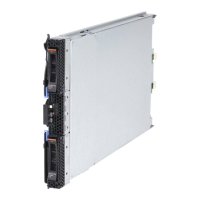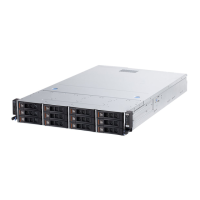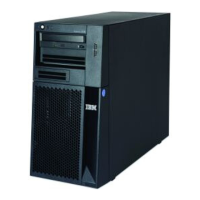1. Obtain a Windows version of the IMM, server firmware, and DSA update
package (see “Firmware updates” on page 62 for more information).
2. Extract the ibm_rndis_server_os.inf and device.cat files from the firmware
update package and copy them to the \WINDOWS\inf subdirectory.
3. For Windows 2003: Install the ibm_rndis_server_os.inf file by right-clicking
on the file and selecting Install. This generates a PNF file of the same name in
\WINDOWS\inf.
For Windows 2008: Go to Computer Management, then Device Manager and
find the RNDIS Device. Select Properties > Driver > Reinstall driver. Point
the server to the \Windows\inf directory where it can find the
ibm_rndis_server_os.inf file and install the device.
4. Go to Computer Management then Device Manager and right-click on
Network adapters and select Scan for hardware changes. A small pop-up
confirms that the Ethernet device is found and installed. The New Hardware
Wizard starts automatically.
5. When you are prompted with the question, “Can Windows connect to
Windows Update to search for software?", select No, not this time. Click Next
to continue.
6. When you are prompted with the question, "What do you want the wizard to
do?", select Install from a list or specific location (Advanced). Click Next to
continue.
7. When you are prompted with the statement, "Please choose your search and
installation options", select Don't search. I will choose the driver to install.
Click Next to continue.
8. When you are prompted with the statement, "Select a hardware type, and
then click Next", select Network adapters. Click Next to continue.
9. You are prompted with the statement, "Completing the Found New Hardware
Wizard". Click Finish.
Note: A new local area connection appears and might state, "This connection
has limited or no connectivity". Ignore this message.
10. Go back to the Device Manager. IBM USB Remote NDIS Network Device
appears under Network Adapters.
11. Open a command prompt, type ipconfig, and press Enter. The local area
connection for the IBM USB RNDIS appears with an IP address in the range of
169.254.xxx.xxx with a subnet mask set to 255.255.0.0.
LAN over USB Linux Driver Installation
Use this information to install the LAN over USB driver for Linux.
Current versions of Linux, such as RHEL5 Update 2 and SLES10 Service Pack 2,
support the LAN over USB interface by default. This interface is detected and
displayed during the installation of these operating systems. When you configure
the device, use a static IP address of 169.254.95.130 with a subnet mask of
255.255.0.0.
Note: Older Linux distributions might not detect the LAN over USB interface, and
might require manual configuration. For information about configuring LAN over
USB on specific Linux distributions, see the IBM white paper Transitioning to UEFI
and IMM on the IBM web site (see “Related documentation” on page 3 for
information on how to find publications for your blade server).
Chapter 4. Configuring the blade server 67

